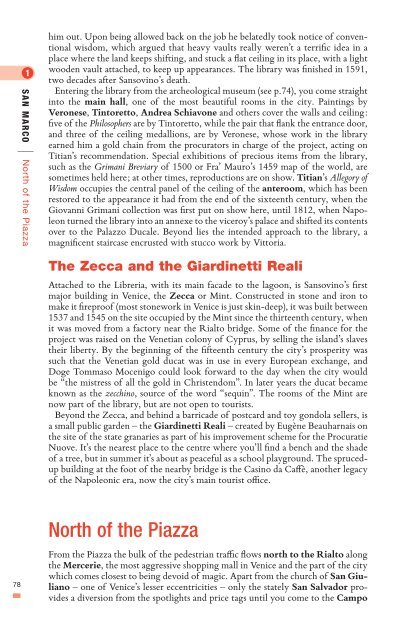Create successful ePaper yourself
Turn your PDF publications into a flip-book with our unique Google optimized e-Paper software.
san marco<br />
|<br />
North of <strong>the</strong> Piazza<br />
him out. Upon being allowed back on <strong>the</strong> job he belatedly <strong>to</strong>ok notice of conventional<br />
wisdom, which argued that heavy vaults really weren’t a terrific idea in a<br />
place where <strong>the</strong> l<strong>and</strong> keeps shifting, <strong>and</strong> stuck a flat ceiling in its place, with a light<br />
wooden vault attached, <strong>to</strong> keep up appearances. <strong>The</strong> library was finished in 1591,<br />
two decades after Sansovino’s death.<br />
Entering <strong>the</strong> library from <strong>the</strong> archeological museum (see p.74), you come straight<br />
in<strong>to</strong> <strong>the</strong> main hall, one of <strong>the</strong> most beautiful rooms in <strong>the</strong> city. Paintings by<br />
Veronese, Tin<strong>to</strong>ret<strong>to</strong>, Andrea Schiavone <strong>and</strong> o<strong>the</strong>rs cover <strong>the</strong> walls <strong>and</strong> ceiling:<br />
five of <strong>the</strong> Philosophers are by Tin<strong>to</strong>ret<strong>to</strong>, while <strong>the</strong> pair that flank <strong>the</strong> entrance door,<br />
<strong>and</strong> three of <strong>the</strong> ceiling medallions, are by Veronese, whose work in <strong>the</strong> library<br />
earned him a gold chain from <strong>the</strong> procura<strong>to</strong>rs in charge of <strong>the</strong> project, acting on<br />
Titian’s recommendation. Special exhibitions of precious items from <strong>the</strong> library,<br />
such as <strong>the</strong> Grimani Breviary of 1500 or Fra’ Mauro’s 1459 map of <strong>the</strong> world, are<br />
sometimes held here; at o<strong>the</strong>r times, reproductions are on show. Titian’s Allegory of<br />
Wisdom occupies <strong>the</strong> central panel of <strong>the</strong> ceiling of <strong>the</strong> anteroom, which has been<br />
res<strong>to</strong>red <strong>to</strong> <strong>the</strong> appearance it had from <strong>the</strong> end of <strong>the</strong> sixteenth century, when <strong>the</strong><br />
Giovanni Grimani collection was first put on show here, until 1812, when Napoleon<br />
turned <strong>the</strong> library in<strong>to</strong> an annexe <strong>to</strong> <strong>the</strong> viceroy’s palace <strong>and</strong> shifted its contents<br />
over <strong>to</strong> <strong>the</strong> Palazzo Ducale. Beyond lies <strong>the</strong> intended approach <strong>to</strong> <strong>the</strong> library, a<br />
magnificent staircase encrusted with stucco work by Vit<strong>to</strong>ria.<br />
<strong>The</strong> Zecca <strong>and</strong> <strong>the</strong> Giardinetti Reali<br />
Attached <strong>to</strong> <strong>the</strong> Libreria, with its main facade <strong>to</strong> <strong>the</strong> lagoon, is Sansovino’s first<br />
major building in <strong>Venice</strong>, <strong>the</strong> Zecca or Mint. Constructed in s<strong>to</strong>ne <strong>and</strong> iron <strong>to</strong><br />
make it fireproof (most s<strong>to</strong>nework in <strong>Venice</strong> is just skin-deep), it was built between<br />
1537 <strong>and</strong> 1545 on <strong>the</strong> site occupied by <strong>the</strong> Mint since <strong>the</strong> thirteenth century, when<br />
it was moved from a fac<strong>to</strong>ry near <strong>the</strong> Rial<strong>to</strong> bridge. Some of <strong>the</strong> finance for <strong>the</strong><br />
project was raised on <strong>the</strong> Venetian colony of Cyprus, by selling <strong>the</strong> isl<strong>and</strong>’s slaves<br />
<strong>the</strong>ir liberty. By <strong>the</strong> beginning of <strong>the</strong> fifteenth century <strong>the</strong> city’s prosperity was<br />
such that <strong>the</strong> Venetian gold ducat was in use in every European exchange, <strong>and</strong><br />
Doge Tommaso Mocenigo could look forward <strong>to</strong> <strong>the</strong> day when <strong>the</strong> city would<br />
be “<strong>the</strong> mistress of all <strong>the</strong> gold in Christendom”. In later years <strong>the</strong> ducat became<br />
known as <strong>the</strong> zecchino, source of <strong>the</strong> word “sequin”. <strong>The</strong> rooms of <strong>the</strong> Mint are<br />
now part of <strong>the</strong> library, but are not open <strong>to</strong> <strong>to</strong>urists.<br />
Beyond <strong>the</strong> Zecca, <strong>and</strong> behind a barricade of postcard <strong>and</strong> <strong>to</strong>y gondola sellers, is<br />
a small public garden – <strong>the</strong> Giardinetti Reali – created by Eugène Beauharnais on<br />
<strong>the</strong> site of <strong>the</strong> state granaries as part of his improvement scheme for <strong>the</strong> Procuratie<br />
Nuove. It’s <strong>the</strong> nearest place <strong>to</strong> <strong>the</strong> centre where you’ll find a bench <strong>and</strong> <strong>the</strong> shade<br />
of a tree, but in summer it’s about as peaceful as a school playground. <strong>The</strong> sprucedup<br />
building at <strong>the</strong> foot of <strong>the</strong> nearby bridge is <strong>the</strong> Casino da Caffè, ano<strong>the</strong>r legacy<br />
of <strong>the</strong> Napoleonic era, now <strong>the</strong> city’s main <strong>to</strong>urist office.<br />
78<br />
North of <strong>the</strong> Piazza<br />
From <strong>the</strong> Piazza <strong>the</strong> bulk of <strong>the</strong> pedestrian traffic flows north <strong>to</strong> <strong>the</strong> Rial<strong>to</strong> along<br />
<strong>the</strong> Mercerie, <strong>the</strong> most aggressive shopping mall in <strong>Venice</strong> <strong>and</strong> <strong>the</strong> part of <strong>the</strong> city<br />
which comes closest <strong>to</strong> being devoid of magic. Apart from <strong>the</strong> church of San Giuliano<br />
– one of <strong>Venice</strong>’s lesser eccentricities – only <strong>the</strong> stately San Salvador provides<br />
a diversion from <strong>the</strong> spotlights <strong>and</strong> price tags until you come <strong>to</strong> <strong>the</strong> Campo







